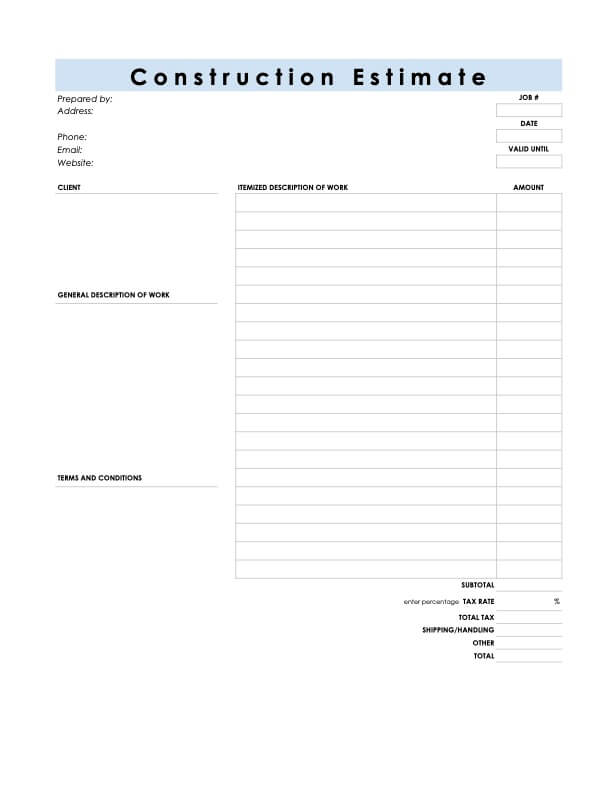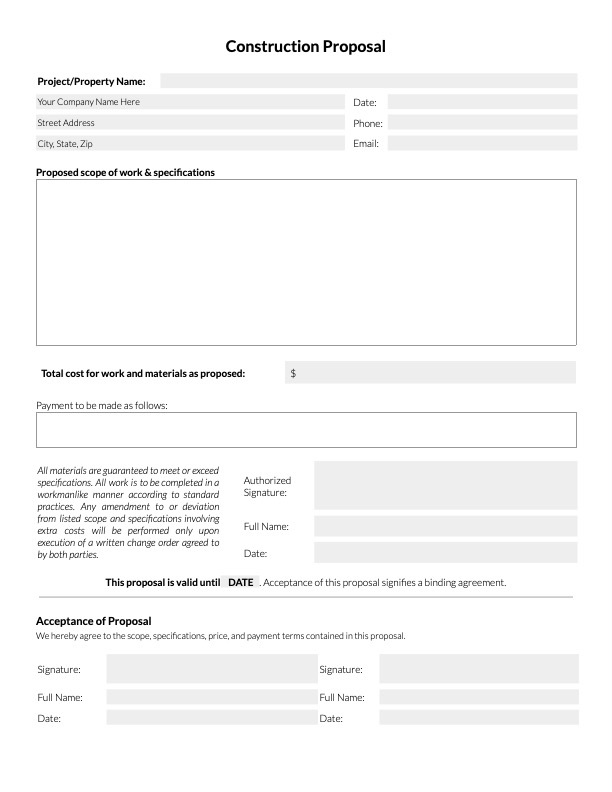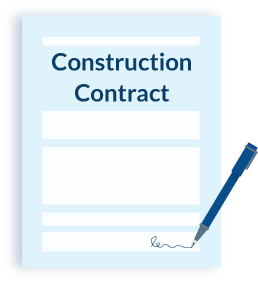
The terms estimate, bid, proposal, and contract are often tossed around as though they’re interchangeable, but they are very different things.
Estimates, bids, and proposals are used to negotiate a sale, whereas a contract is a legally binding agreement. All of these can be useful tools to prevent disputes as long as they are used correctly. When confused, these different types of documents can lead to misunderstandings.
Read on to make sure you understand the differences for your contracting business.
The difference between estimates, bids, proposals, and contracts
- An estimate is a guess. Usually it’s an educated guess, based on pricing data, construction drawings, and other information.
- A proposal or a bid is an offer. These are offers to do a certain scope of work for a specified price, usually in a specified amount of time.
- A contract is a commitment. Both parties have agreed to the terms of the proposal. One has promised to provide a specified amount of goods and services and the other has promised to pay a specified amount of money in return.
Some confusion can happen when these terms are used or interpreted incorrectly. This can create differing expectations, which can lead to disagreements, which can lead to payment disputes — and even legal action. So, it’s critical to get the terminology right in the beginning and make sure your client understands exactly what you mean.
Construction estimates
In-house, you may “estimate” a job to inform a proposal, and many contractors have estimators who do just that. But there’s a difference between estimating a project’s cost and producing an estimate for a client.
But when you’re dealing with a client, the word “estimate” simply means an informed guess. Often, a client just wants a ballpark figure to decide whether a job is even in the realm of possibilities for them.
Let’s say a client is dreaming of a new bathroom and wants an estimate. You’ll make some assumptions, maybe use per-square-foot calculations, check comparisons to similar jobs, and apply rules of thumb to imagine, roughly, what a new bathroom would cost.
But there are still a lot of unknown variables: You haven’t yet checked out where the mains are located, how much the cost of drywall has gone up this week, whether you can get the marble they want locally, or whether that storm took all the carpenters south. So, you don’t know for sure if that $30,000 is enough to do the job, and this is where the trouble can start. Your client doesn’t know what you don’t know.
Your client called you because you’re the pro. They expect you to know everything about what you’re doing, and they take what you say seriously.
When you say “estimate” they often hear “price.” If you say, “A new bathroom will probably be around $30,000,” they may very well grab onto that number and expect that to be the price.

Free construction estimate template
Use this free template to write up an estimate to share with a potential customer.
Here’s where your words can save the day.
“A new bathroom is usually around $30,000,” is legally very different from “I’ll build you a new bathroom for $30,000.” One is general information, the other is a commitment.
So, when you give a client an estimate, you should always follow it up immediately with “But that’s just an estimate. I’d need to work up a proposal to give you a hard number.” You want to be clear that the estimate is not binding.
This is also why it’s best to keep estimates verbal. If you put an estimate in writing, it implies that your numbers are fixed, and clients often mistake this for a quote. They got it in writing, after all.
Contractors often present clients with something written that says “estimate” at the top — but has a place for signatures at the bottom.
This is confusing and dangerous. If you and/or a client sign a piece of paper, no matter what it’s called, an agreement is implied, and that client will now believe that your guess is a hard number — and their lawyer will likely agree. So, when you’re just offering a guess, make sure everyone understands clearly that that’s what is.
When you’re delivering an estimate for a client, don’t include these items:
- Specific quantities
- A time frame for the work
- An expiration date for the “estimate” (this implies that the number is tied to market conditions and can be argued to constitute a proposal)
Great! Now you’ve given your client an estimate and they want to move forward. The next thing to do is go from the general to the specific, and from a guess to an offer.
Related: 8 estimating mistakes contractors make on renovation projects
Contractor bid or proposal
A construction bid or proposal is essentially an offer.
A bid usually implies competition, meaning that there are other people offering proposals for the same work. This is known as a competitive bid.
But in any case, you are offering to perform specific services for a specific sum. And since it can be accepted, an offer has to be much more specific than an estimate.
Since your proposal will soon hopefully be the basis of a contract, you want to make sure that your price is more than a guess. A detailed, in-house accounting of the construction budget, based on a real understanding of the project requirements, will allow you to submit an accurate proposal to your client.
It may be a little higher or lower than the estimate you gave them, but since you made it clear to them that the estimate was not the final number, their expectations are managed.
What’s important now is that the price and time are accurate so the client can rest assured that everything will get done for the quoted price and you can be sure that you’ll do what you set out to do — make a profit.

Free contract proposal template
Download a free customizable template to provide a bid or proposal to a customer on a construction project.
When writing a proposal, you should always include the following items:
- A clearly defined scope of work
- A time frame for project completion
- An expiration date for the proposal (this protects you from doing work next year for this year’s prices)
- A signature line (as soon as they accept the proposal, it’s a contract. It’s good to make that clear by calling it out in the proposal)
Now, you’ve put together a proposal with a very specific scope of work and a well-thought-out price of $31,455 to build the new bathroom. You presented the proposal to your client and they’ve accepted, which means you have the job. Congratulations!
But now that they’ve signed, you also now no longer have a proposal — you have a contract.
Construction contract
A legal contract is simply an accepted offer. It means you promise to do the work specified, and the client promises to pay you the agreed-upon sum.
While an estimate is just information, and a proposal can be changed or withdrawn at any time, a contract is binding. You are legally bound to honor its terms, which can only be changed by mutual consent, typically for mutual benefit.
Things are fixed and the terms are locked. Now, you’re counting on your proposal to be thorough, because you can’t just go back to your client for more money if that countertop was harder to set than you thought it would be. Which is fair, because they can’t come to you and ask for a discount because the money was harder to earn than they expected.
That’s the whole point of a contract — to fix the limits of the work, the time, and the cost. And those terms can only be changed under certain circumstances, otherwise, they could be seen as a breach.

Free construction contract templates
Get a free, customizable contract template you can tailor to your project:
However, even with a firm contract, there are reasons that changes could occur:
- Existing conditions were not as expected
- The client changed their mind or added to the scope of work
- Revisions to local codes or ordinances that you could not foresee
But other situations will not lead to a change in the contract:
- You forgot to include something
- Your costs went up
- Something took longer than you expected
It pays to understand estimates, proposals, bids, and contracts
You were so clear about the limits of the estimate, did a fine job on the proposal, and communicated so clearly with the client that there will be little to no reason to make changes to the contract.
Now, you can do what you do best: Build a spectacular new bathroom and send a happy client out into the world to say good things about you (and send more business your way).
Since your communication was so clear, the owner didn’t confuse your estimate with a proposal, and they fully understood the obligations of the contract. So they’ll happily (or at least willingly) pay your invoices in full and on time, avoiding payment disputes and keeping your cash flow healthy.